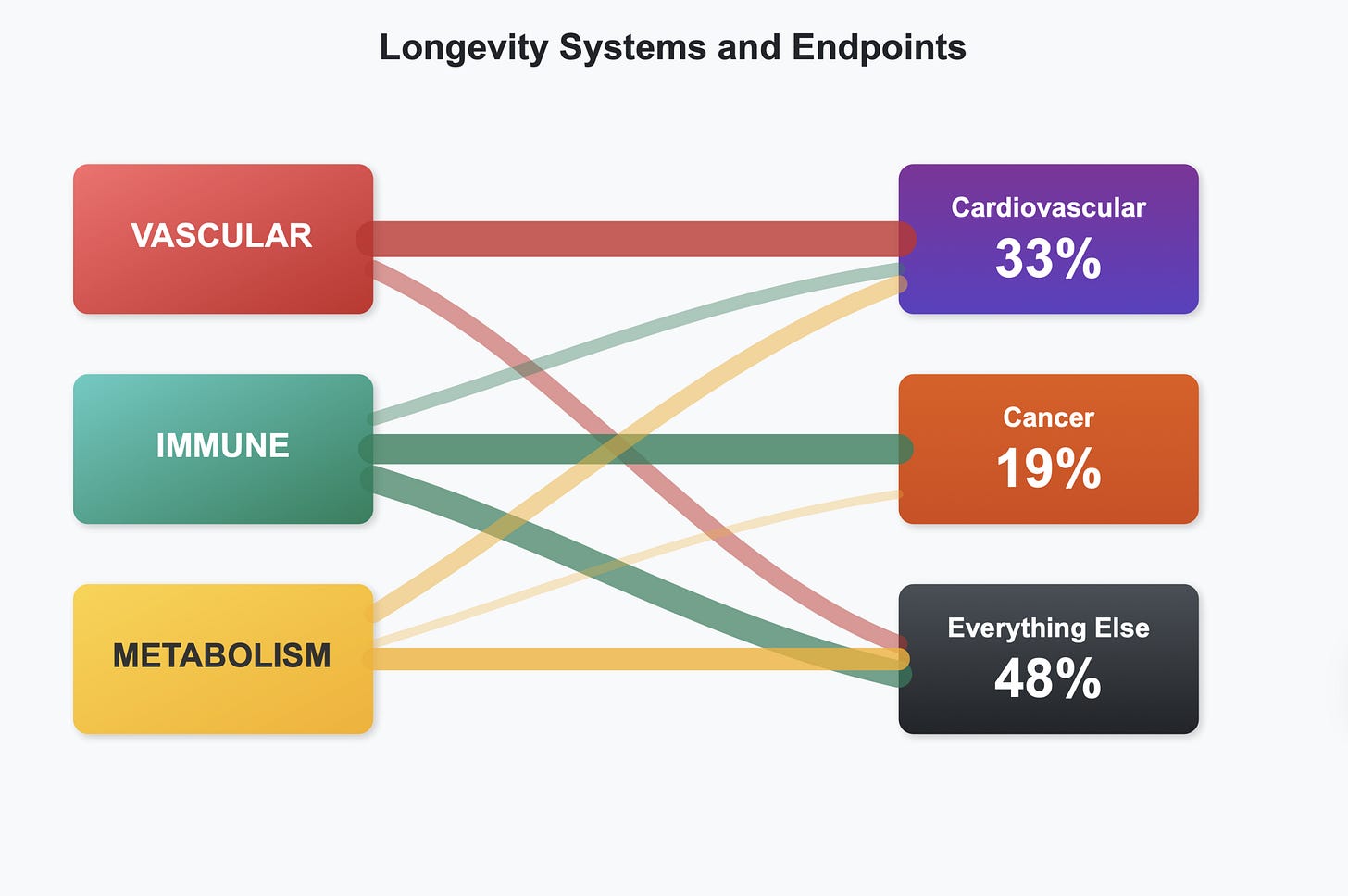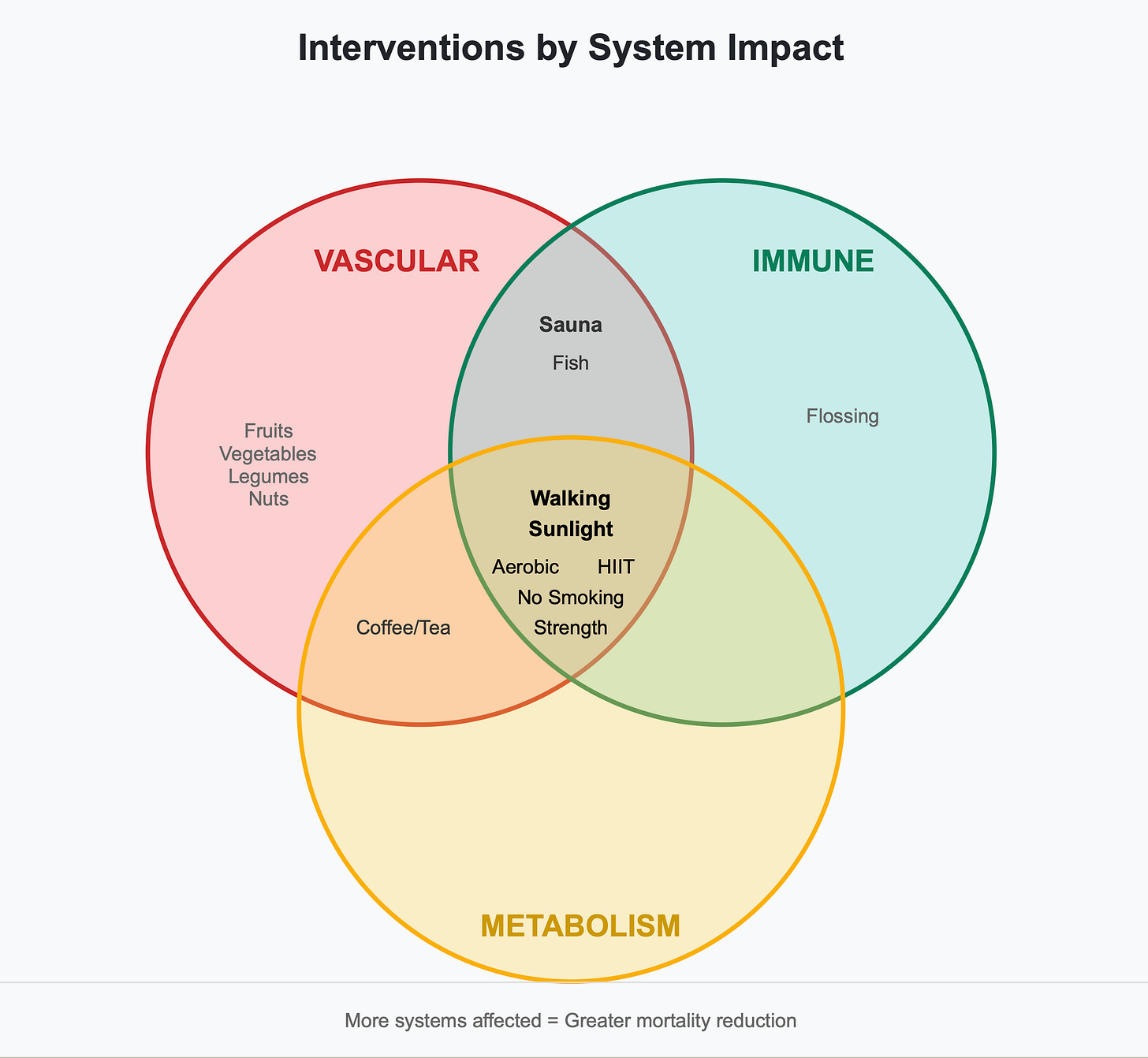The Real Pathways to Longevity
A Factorial Analysis
While aging researchers chase exotic targets with 7-point plans and 11-step protocols, longevity comes down to preventing two fundamental biological failures. Forget the laundry lists of obscure biomarkers—here’s what actually extends life.
The Problem with Aging “Solutions”
The longevity field loves complex frameworks. Aubrey de Grey’s SENS Research Foundation identifies seven types of aging damage. The Hallmarks of Aging paper lists twelve interconnected processes—including “deregulated nutrient sensing” focused on pathways like mTOR and insulin/IGF-1 signaling. Dr. Greger’s “How Not to Age” identifies eleven pathways—including boosting autophagy with spermidine from tempeh and targeting cellular senescence with quercetin from onions.
These approaches treat aging like a collection of separate problems requiring separate solutions. But longevity doesn’t come from optimizing eleven separate pathways or targeting seven types of damage. Life extension happens when you address three fundamental protective mechanisms that prevent multiple failure modes simultaneously. Everything else is just detail.

The Two Major Death Endpoints
Human mortality is surprisingly concentrated. Looking at global data:
Cardiovascular Disease: Heart diseases are responsible for about a third of all deaths worldwide, with ischemic heart disease alone accounting for 13% of global deaths. Approximately 33% of all deaths globally1.
Cancer: Almost one-in-five deaths globally. Taken together, heart diseases and cancers cause over half of deaths. Approximately 19% of all deaths globally2.
Everything Else: The remaining 48% fragments across dozens of smaller categories—chronic obstructive pulmonary disease (COPD) (5%), infectious diseases (3.7%), Alzheimer’s (2.6%), diabetes (2-3%), injuries (4%), autoimmune diseases (~0.5%), and many others. However, infectious diseases represent a significantly larger burden when considering their role as intermediate causes of death, accounting for approximately 14 million deaths annually when including infections that co-occur with other conditions3.
This distribution explains why much longevity research focuses on “CVD, cancer, and other.” These are the only two causes representing truly massive mortality burdens.
The Three Key Longevity Systems
Understanding death through these two major endpoints reveals why certain interventions are so powerful. The most effective approaches simultaneously target multiple biological systems:
1. Vascular System
Keeps tissues alive by delivering oxygen and nutrients through healthy blood vessels.
Primary endpoint: Cardiovascular disease (~33% of global deaths)4.
Secondary outcomes: Stroke, vascular dementia, kidney failure, vision loss.
Why it matters: Elevated blood pressure and atherogenic lipids are the most powerful and widespread modifiable killers.
Biomarkers:
Blood pressure: Direct measure of vascular stress.
ApoB: Best marker of atherogenic particle number and cardiovascular risk.
LDL-C: Standard fallback if ApoB is not available.
2. Immune System Regulation
Longevity requires balance—quieting chronic inflammation while maintaining defense against pathogens and tumors.
Primary endpoint: Cancer (~19% of global deaths)5.
Secondary outcomes: Infections (~7% of global deaths), autoimmune disease, COPD.
Why it matters: Inflammation destabilizes plaques and promotes tumor environments, while immune senescence lets cancers and infections progress unchecked.
Biomarkers:
CRP (high-sensitivity): Shows whether chronic background inflammation is elevated or low.
WBC (white blood cell count): Confirms the immune system can still respond effectively to pathogens.
3. Energy Metabolism
Determines how efficiently the body processes glucose and fats for repair and resilience.
Primary endpoint: Diabetes (2–3% of global deaths, plus a major CVD multiplier)6.
Secondary outcomes: Cancer fueling (glucose-driven tumor growth), frailty and sarcopenia.
Why it matters: Poor glucose control accelerates vascular disease and undermines cellular resilience.
Biomarkers:
HbA1c: Best marker of long-term glucose control.
Fasting glucose: Basic, universal test for baseline sugar regulation.
VO₂max: Reflects whole-body energy capacity; overlaps with vascular health as higher cardiorespiratory fitness requires both efficient metabolism and intact circulation.
Why Multi-System Interventions Dominate
The three longevity systems—vascular, immune, and metabolism—don’t operate in isolation. Interventions that touch more than one system shift all-cause mortality, while single-system tweaks barely register. Your longevity tier isn’t about which systems you hit, but how many you impact, how strongly, and how sustainably.
S-Tier
Walking: Improves vascular health (endothelial function, lower blood pressure), strengthens immune balance (lower CRP, better surveillance), and enhances metabolism (insulin sensitivity). Its edge is volume—you can do hours daily without injury risk.
Sunlight: Supports vascular function via nitric oxide release, strengthens immune rhythm through vitamin D and circadian alignment, and improves metabolism through infrared-driven mitochondrial efficiency.
A-Tier
Aerobic exercise: Improves vascular function (endothelial health, blood pressure), reduces inflammation (immune), and builds metabolic capacity (mitochondrial biogenesis, glucose uptake).
HIIT: Creates vascular shear stress (vascular), lowers systemic inflammation (immune), and increases mitochondrial efficiency (metabolism).
Strength training: Improves vascular function (blood pressure), reduces inflammation via myokines (immune), and increases metabolic reserve through greater muscle mass and glucose disposal.
Sauna: Promotes vasodilation and lowers blood pressure (vascular), activates heat-shock proteins that regulate inflammation (immune), and enhances VO₂max adaptation in training (metabolism).
Smoking cessation: Removes endothelial toxins (vascular), lowers chronic inflammation (immune), and restores oxygen transport capacity that supports metabolism.
B-Tier
Fish: Improves vascular health (endothelial function, triglycerides) and supports immune regulation (cytokine signaling).
Coffee/Tea: Supports vascular function (endothelial health) and energy metabolism (liver function, glucose regulation).
Nuts: Improve vascular health (lipid handling).
C-Tier
Flossing / oral hygiene: Reduces chronic gum inflammation and systemic CRP (immune).
Fruits, vegetables, legumes: Support vascular health (soluble fiber lowers LDL/ApoB).
The pattern:
S-Tier = broadest system coverage + highest feasible dose.
A-Tier = multi-system, but limited by intensity, access, or applicability.
B-Tier = two systems, narrower scope.
C-Tier = single-system, incremental gains.
This factorial view explains why walking, sunlight, exercise, sauna, and smoking cessation dominate: they push on multiple levers of survival at once, while foods and micro-habits mostly act through one.
The overlaps are large—most S-tier and A-tier interventions help all three systems to varying degrees. Where should you start? Whatever S-tier or A-tier intervention you’re not doing now will give you the most benefit.
Working With Evolution, Not Against It
This framework reveals a crucial insight: the most effective longevity interventions work with evolution rather than trying to hack it. The body has evolved sophisticated responses to exercise that increase fitness across multiple systems simultaneously. Modern science confirms what hunter-gatherers have demonstrated for millennia—regular physical activity triggers coordinated improvements throughout the body7.
When you walk or do strength training, you’re activating millions of years of evolutionary programming. Exercise triggers the same stress-response systems that helped our ancestors survive—improved circulation to deliver oxygen during hunts, stronger muscles for carrying tools and prey, enhanced immune function to fight infections, and better cellular energy production for sustained activity.
Contrast this with taking a peptide injection to boost muscle growth. You’re attempting to micromanage one specific pathway while potentially creating unknown downstream effects. You’re essentially telling your body to do something it wasn’t designed to do, rather than triggering the natural adaptive responses it has perfected over evolutionary time.
The body already knows how to live longer. The factorial framework reveals that the most powerful longevity interventions simply activate these evolved mechanisms rather than trying to override them.
Clinical Applications
This factorial approach reveals why complex aging protocols often fail while simple interventions succeed:
The Multi-System Advantage
Interventions targeting multiple systems provide exponentially greater benefits than the sum of their parts. Walking doesn’t just add vascular and mitochondrial and inflammatory benefits—it creates synergistic effects where each system enhancement amplifies the others.
Resource Allocation Priority
Time and effort should prioritize interventions based on system breadth:
S-tier (2-3 systems): Walking, sunlight exposure
A-tier (2-3 systems): HIIT, sauna, strength training
B-tier (1-2 systems): Coffee, nuts, fish
C-tier and below (≤1 system): Most supplements and dietary micromanagement
Where should you start? Whatever S-tier or A-tier intervention you’re not doing now will give you the most benefit.
The Stacking Principle
Lower-tier interventions work best as additions to, not replacements for, higher-tier practices. B-tier and C-tier interventions can provide marginal gains when S-tier and A-tier foundations are established.
One hour of walking provides more death prevention than hours spent optimizing single-system interventions like fruit intake.
The Bottom Line
Longevity isn’t about hacking 12 hallmarks or chasing exotic supplements. It’s about reinforcing three systems that cover over 60% of deaths directly—and influence much of the rest. Walking, sunlight, and exercise protect all three. That’s why they work.




